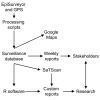Mobile phone-based infectious disease surveillance system, Sri Lanka
- PMID: 20875276
- PMCID: PMC3294391
- DOI: 10.3201/eid1610.100249
Mobile phone-based infectious disease surveillance system, Sri Lanka
Abstract
Because many infectious diseases are emerging in animals in low-income and middle-income countries, surveillance of animal health in these areas may be needed for forecasting disease risks to humans. We present an overview of a mobile phone-based frontline surveillance system developed and implemented in Sri Lanka. Field veterinarians reported animal health information by using mobile phones. Submissions increased steadily over 9 months, with ≈4,000 interactions between field veterinarians and reports on the animal population received by the system. Development of human resources and increased communication between local stakeholders (groups and persons whose actions are affected by emerging infectious diseases and animal health) were instrumental for successful implementation. The primary lesson learned was that mobile phone-based surveillance of animal populations is acceptable and feasible in lower-resource settings. However, any system implementation plan must consider the time needed to garner support for novel surveillance methods among users and stakeholders.
Figures




References
-
- Rabinowitz PM, Gordon Z, Holmes R, Taylor B, Wilcox M, Chudnov D, et al. Animals as sentinels of human environmental health hazards: an evidence-based analysis. EcoHealth. 2005;2:26–37. 10.1007/s10393-004-0151-1 - DOI
Publication types
MeSH terms
LinkOut - more resources
Full Text Sources
Other Literature Sources
Medical
